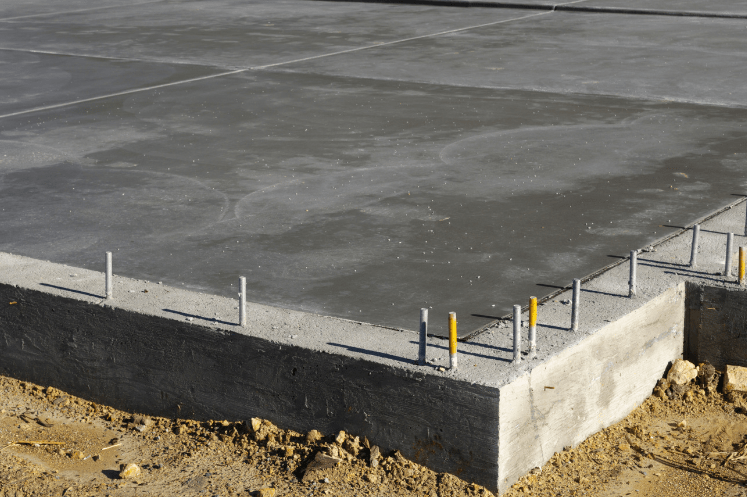When we think of our dream home, we often visualize its design, the layout of its rooms, and the memories we will create inside. However, before any window frames a sunset or a door opens to new experiences, there is one essential element that must be carefully considered: the foundation. The foundation of a home is the base on which everything else is built. It is the support that ensures that the structure stands firm in the face of inclement weather and the challenges of the terrain. In this guide, Velló Monfort Arquitectes will take you through the basics of the foundation, from its importance to the details of its implementation, ensuring that your home rests on a foundation as solid as the memories it will house.
What is the foundation and why is it so important?
The backbone of your home
The foundation is, in essence, the backbone of your home. It is the subway infrastructure that supports the weight of the building, distributing loads to the ground evenly and stably. A proper foundation prevents uneven settlement, protects against flooding and resists seismic forces. It is the foundation that determines the strength and longevity of your home’s structure. Without a well-designed and constructed foundation, even the most beautiful home can face serious structural problems in the future.
Contact our architectural firm
Types of foundations: Advantages and disadvantages
Shallow foundation: Is it suitable for your home?
The shallow foundation is the most common and is used when the top layers of soil have the capacity to support the weight of the structure. This type of foundation is cheaper and faster to construct, but its effectiveness is limited by the quality of the soil. It is ideal for lighter structures and in areas where the soil is consistent and firm. However, it is not suitable for soils with poor bearing capacity or for heavy structures, as the risk of settlement and structural damage increases significantly.
Deep foundations: Deepening stability
When the surface soil is not suitable, deep foundations are used. This type of foundation transfers loads to deeper, more stable layers of soil, using elements such as piles or caissons. Although more costly and technical than shallow foundations, deep foundations are crucial for tall buildings, bridges and structures on unstable soils. Its design must be carried out by specialized engineers, as an incorrect calculation can have disastrous consequences.
Semi-deep foundations: The middle ground
In some cases, neither shallow nor deep foundations are the most viable option. This is where semi-deep foundations come into play, which are used when shallow soil layers have adequate capacity to support structural loads. This type of foundation can include slab foundations, footings connected by foundation beams or short piles. It offers a balance between cost and stability and is suitable for a variety of buildings, including those in areas with moderate variations in soil quality.
The foundation process: A step-by-step approach
Soil survey: The first and most crucial step
Before the first cubic meter of concrete is poured or the first brick is laid, a soil survey is imperative. This analysis is crucial to understand the composition, bearing capacity and properties of the soil where the structure will settle. A soil survey can prevent future problems, such as differential settlement or structural failure, and is a step that should not be ignored under any circumstances.
From theory to practice: preparing the ground
Once you have a clear understanding of the soil, the next step is site preparation. This process includes clearing the site, excavating to the desired depth and leveling the ground. It is critical to ensure that the ground is adequately prepared to receive the foundation, as any oversight at this stage can compromise the integrity of the entire structure.
Foundation materials: Beyond concrete
Concrete is the material most commonly associated with foundations, known for its strength and durability. However, it is not the only option. In some cases, alternative materials such as steel, treated wood or even advanced composite materials are used. The choice of material will depend on several factors, including the type of foundation chosen, soil conditions and the specific requirements of the structure.
Foundation costs
How much should you spend on the foundation?
The cost of the foundation can vary significantly depending on the complexity of the project and the materials selected. It is important to keep in mind that skimping on the foundation can result in much higher costs in the long run due to structural repairs and reinforcements. We will provide a breakdown of average costs, but it is vital to obtain a detailed, customized quote from reliable professionals before making any financial decisions.
Innovations in foundations: Looking to the future
Emerging techniques and materials
The field of foundations is constantly evolving, with new techniques and materials seeking to improve efficiency and reduce environmental impact. From foundations that use polymers to techniques that minimize soil disturbance, innovations in this space not only promise safer and more sustainable structures, but also more agile and less costly construction processes.
Frequently asked questions on foundations
Resolving your doubts
Foundations are a complex subject and it is natural to have questions. Here we will address some of the most common queries to provide clarity and confidence in your construction project.
How does climate affect the foundation of a house?
Weather can have a significant impact on the foundation. For example, in areas with freeze-thaw cycles, it is crucial that the foundation extend below the frost line to avoid soil heave and shrinkage that can damage the structure.
Is it possible to change the foundation once the house is built?
Modifying the foundation of an existing house is possible, but it is a complex and costly process that usually involves reinforcing or extending the existing foundation. It is a task that must be evaluated and executed by experienced professionals.
What maintenance does a foundation require?
Maintenance of the foundation includes ensuring that drainage around the house is working properly to prevent water accumulation and regular inspection for cracks or unusual movement in the foundation.
In conclusion, the foundation is the pillar on which everything else in your home is built. A well-designed and executed foundation is an investment in the safety, stability and durability of your home. At Velló Monfort Arquitecteswe understand the importance of this crucial element and are committed to providing foundation solutions that not only meet the highest standards of quality and safety but also fit the needs and budgets of our clients. By choosing the right foundation and making sure it is implemented correctly, you are laying the foundation for a home that will last through the generations.


